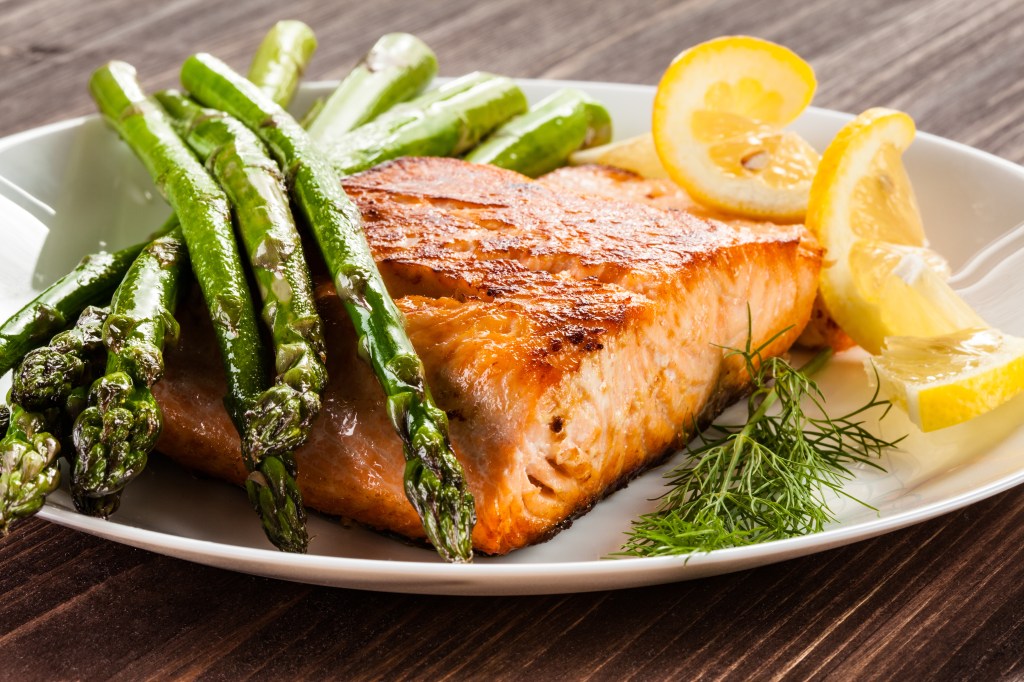At a glance
There are several essential omega-3 fatty acids, but not all food sources provide them in the same balance or bioactive form. The best sources of omega-3 fatty acids primarily come from fish, which deliver highly bioavailable omega-3s that the body can utilise immediately. Prioritizing whole-food sources of omega-3s helps support healthy cell membranes, cognitive function, and overall metabolic balance.
Omega-3 fatty acids are essential fats found in various plant and animal foods. They influence nearly every system in the body, supporting heart health, brain performance, and cellular resilience.
Discover the best dietary source of omega-3 fatty acids and learn which foods deliver the most bioavailable forms to support long-term health.
What are omega-3 fatty acids?
Omega-3 fatty acids are a family of essential polyunsaturated fatty acids (PUFAs) that are crucial for supporting many physiological processes, including cognitive, cardiovascular, metabolic, and hormonal functions.
Because the body can’t produce omega-3 fatty acids, these fats are classified as essential and must be consumed from dietary sources.
There are three primary types of omega-3 fats:
- Alpha linolenic acid (ALA)
- Eicosapentaenoic acid (EPA)
- Docosahexaenoic acid (DHA)
Here’s how each of these fatty acids functions in the body.
1. ALA
ALA is a plant-based omega-3 fat found in flaxseed, chia seeds, walnuts, and leafy greens.
It serves as both an antioxidant that helps protect cell membranes from oxidative stress and a building block for the body to produce EPA and DHA.
However, the conversion rate of ALA to EPA or DHA is often less than 10 percent, making vegetarian sources alone insufficient to provide the same nutritional benefits as foods that naturally contain EPA and DHA.
2. EPA
EPA circulates in the bloodstream, where it supports cardiovascular functions, cellular membrane integrity, and the body’s inflammatory responses.
It’s especially known for helping maintain normal cholesterol and triglyceride levels and promoting metabolic health.
3. DHA
DHA has the longest, most flexible carbon chain of all omega-3 fats. This supports the structure and function of cell membranes throughout the body by facilitating their fluidity and allowing signals to move more quickly and efficiently between cells.
This fatty acid is especially concentrated in the brain, and research published in Cureus notes that DHA makes up more than 40 percent of the omega-3 content in gray matter, underscoring its central role in memory, focus, and vision.
Watch the video below to discover how omega-3 fatty acids support overall health.
Benefits of omega-3s
Omega-3 fatty acids are essential for the proper functioning of nearly every system in the body.
“Omega-3 fats are built into the wiring of your brain, your immune system, and your cells,” explains Dr. Berg. “When there’s a lack of these fatty acids, those systems can’t function correctly, which is why it’s crucial to get optimal amounts from high-quality food sources.”
Omega-3 fatty acids are a significant component of cell membranes, influencing flexibility, communication, energy production, and the activity of receptors that regulate gene expression, hormone signaling, and metabolic processes.
They also promote skin hydration and resilience, support balanced cholesterol levels, keep arteries flexible, and encourage smooth circulation. This explains why omega-3 fats are often called heart-healthy and linked to a lower risk of cardiovascular disease.
Omega-3 fats are highly concentrated in the brain and eyes, where they strengthen neural and visual pathways and help preserve signaling speed and integrity.
Furthermore, evidence published in Combinatorial Chemistry & High Throughput Screening highlights the beneficial effects of omega-3 fats on the gut microbiome, the intestinal barrier, metabolic functions, and immune balance.

How much omega-3 fatty acids do I need?
While there’s no single agreed-upon daily intake requirement for omega-3 fats, it’s generally recommended to aim for around 200 to 800 milligrams of combined DHA and EPA. This translates roughly to at least two servings of oily fish per week.
Research published in The American Journal of Clinical Nutrition found that a total omega-3 fat intake of 500 to 800 mg daily reduced mortality in male myocardial infarction survivors by 29 percent compared with those who didn’t obtain adequate amounts.

The best sources of omega-3 fatty acids
Because the human body converts ALA to EPA and DHA at low rates, the most effective way to get significant amounts of bioactive omega-3 fats is to consume oily fish, which are exceptional sources of EPA and DHA.
Here are four of the best dietary sources of omega-3 fatty acids.
1. Cod liver
According to research published in Molecular Nutrition & Food Research, 100 grams of canned cod liver can provide as much as 32 grams of omega-3 fats, including about 18 grams of DHA.
This makes cod liver one of the best whole-food sources of long-chain omega-3 fats available. In addition, cod liver naturally delivers fat-soluble vitamins, including vitamins A and D3.
Cod liver has a mild, buttery flavor compared to many oily fish. It can be enjoyed straight from the can, served over salads, or blended into Healthy Keto® dishes such as Keto Miso Deviled Eggs or tuna salad.
2. North Atlantic mackerel
According to a study published in Environmental Research, Atlantic mackerel contains an average of 71 g of total omega-3 polyunsaturated fatty acids per 100 g of fish.
In addition to omega-3 fats, mackerel provides high-quality protein, vitamin B12, selenium, and vitamin D.
With its bold flavor, mackerel can be grilled, smoked, pan-seared, or blended into spreads and salads. It pairs exceptionally well with lemon, mustard, and fresh herbs.

3. Sardines
Sardines are a nutrient-dense fish and a convenient source of omega-3 fats.
A 100-g serving provides about 473 mg of EPA and 509 mg of DHA, for a total of 982 mg of omega-3 fatty acids. Some varieties, depending on the environment, reach up to 1430 mg of omega-3 fats.
They’re also rich sources of essential nutrients, including highly bioavailable calcium, potassium, iron, vitamin D, and vitamin B12.
Sardines naturally contain very low mercury levels, making them one of the safest seafood options to obtain these health-promoting fatty acids.
Sardines have a salty and savory flavor and can be enjoyed straight from the tin, added to salads, mashed with avocado, or used in Healthy Keto dishes such as seafood stews or Keto Pizza.
4. Anchovies
A 100-g serving of anchovy fillet provides up to 880 mg of EPA and DHA, though this can vary depending on where the fish have been harvested.
While sardines contain a higher total amount of EPA and DHA, anchovies deliver more DHA in polar lipids, suggesting superior bioavailability for certain tissues.
Polar lipids make up cell membranes and help omega-3 fats to be better absorbed and incorporated into tissues such as the brain, eyes, and heart.
The savory flavor of anchovies lends itself well to Mediterranean-style meals, such as Caesar dressing, tapenade, or as a topping for vegetable dishes.
Key takeaways
- Omega-3 fatty acids are essential fats that support cell membrane integrity, brain performance, cardiovascular health, and metabolic balance.
- Plant foods offer ALA-based omega-3s, but only a small portion converts into the long-chain forms the body relies on, which is why animal-based foods are the most reliable sources.
- The best dietary source of omega-3 fatty acids is oily fish, such as North Atlantic mackerel, sardines, anchovies, and cod liver.
FAQ
1. What is the best source of omega-3 fatty acids?
Cod liver and oily fish such as North Atlantic mackerel, sardines, and anchovies are among the richest natural sources of eicosapentaenoic acids (EPA) and docosahexaenoic acids (DHA).
These oily fish species provide some of the highest amounts of omega-3 fatty acids in bioavailable forms that the body can utilize immediately.
2. What depletes omega-3 in the body?
Diets high in processed seed oils and refined carbohydrates, along with a diet lacking oily fish and seafood, can lower omega-3 levels over time.
Excess intake of omega-6 fats, especially from refined vegetable oils, also interferes with omega-3 metabolism by influencing how the body processes them.
3. Are any fruits or vegetables high in omega-3?
Few fruits or vegetables contain meaningful amounts of omega-3s. While some seeds and nuts provide high amounts of alpha linoleic acid (ALA), its conversion to EPA and DHA is inefficient. As a result, fatty fish is the most reliable source of bioavailable omega-3 essential fatty acids.
4. Are eggs high in omega-3s?
Depending on their quality, eggs can be an excellent source of omega-3s. Conventionally produced eggs tend to have low omega-3 levels due to the hen’s diet being typically high in omega-6 fatty acids from grains.
In contrast, pasture-raised eggs can offer up to 2.5 times more omega-3 fats and a much better omega-3 to omega-6 ratio due to a more balanced diet of grass, seeds, and insects.
5. Is every type of fish high in omega-3?
No, not all types of fish contain high levels of EPA and DHA. Oily fish such as wild-caught North Atlantic mackerel, lake trout, salmon, herring, sardines, and anchovies are excellent sources of healthy unsaturated omega-3 fatty acids.
Due to the higher risk of mercury contamination, large, predatory fish species, such as king mackerel, swordfish, and albacore tuna, should be limited.
6. What health benefits are omega-3s linked to?
Omega-3s support cell membrane flexibility and brain performance, and are often linked with cardiovascular function and support for factors tied to heart disease risk and high blood pressure.
Foods rich in omega-3 fats may also help support joint comfort in rheumatoid arthritis, protect cognitive function in Alzheimer’s disease, and maintain eye health in those with age-related macular degeneration.
Sources
- https://pmc.ncbi.nlm.nih.gov/articles/PMC9641984/
- https://www.benthamdirect.com/content/journals/cchts/
- https://pubmed.ncbi.nlm.nih.gov/38578269/
- https://onlinelibrary.wiley.com/doi/abs/10.1002/1521-3803.
- https://www.sciencedirect.com/science/article/pii/S0013935124009253


















